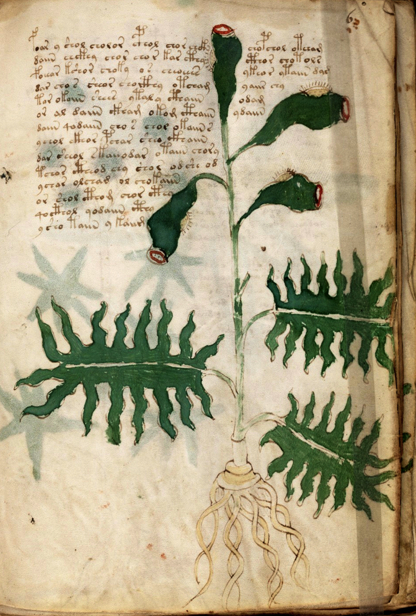 Description
Description
Plant 6r fills up most of the page from top to bottom and left to right. It has palmate green “wiggly” leaves alternating on a central stalk, and what appears to be a fairly prominent central vein (somewhat reminiscent of several members of the Lactuca family).
The stem is slender and has a spike of seed capsules with distinctive openings at the ends. There’s also a very odd yellowish bump on their backs. They are colored a pale yellow and have little lines radiating outwards.
The roots look more metaphoric than naturalistic to me. At first glance they reminded me of jellyfish or hair tendrils like those on a doll’s wig, or maybe skeins of yarn. I wondered if this might be an aquatic or wetland plant, since the roots look like they might be suspended in water.
Prior Identifications
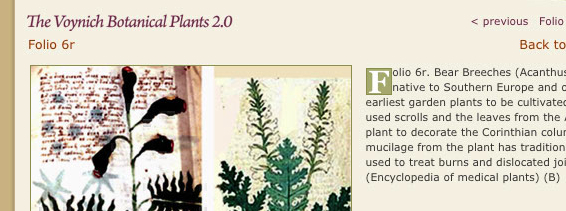 Edith Sherwood has identified 6r as Acanthus mollis, a well-known plant commonly called Bear’s Breeches, probably due to the spiny claw-like leaf margins. Acanthus has a very distinctive leaf that has inspired countless decorative elements in architecture and furnishings. Corinthian columns are often carved with Acanthus motifs.
Edith Sherwood has identified 6r as Acanthus mollis, a well-known plant commonly called Bear’s Breeches, probably due to the spiny claw-like leaf margins. Acanthus has a very distinctive leaf that has inspired countless decorative elements in architecture and furnishings. Corinthian columns are often carved with Acanthus motifs.
I can see why Acanthus might be offered as an ID. The leaves are odd-pinnatish and it has a tall flower stalk. Even the roots might be a good match, but somehow I didn’t get that satisfying, “Yeah, that’s it!” feeling when I looked at VMS 6r next to the picture of Acanthus. Acanthus has a basal whorl and the VMS plant has alternate leaves, the Acanthus leaves are serrated (spiny) and the VMS leaves look softer and wigglier, as though they might be ruffled rather than spiny, or as if viewed through water. I felt there might be a better ID.
Other Possibillities
The first time I saw Plant 6r, the leaves struck me as somewhat palm-like or philodendron-like except that the seed pods (assuming they are pods and not buds) are out of proportion to palm trees and not at all like any philodendron I know, so neither of those seemed like good paths to follow.
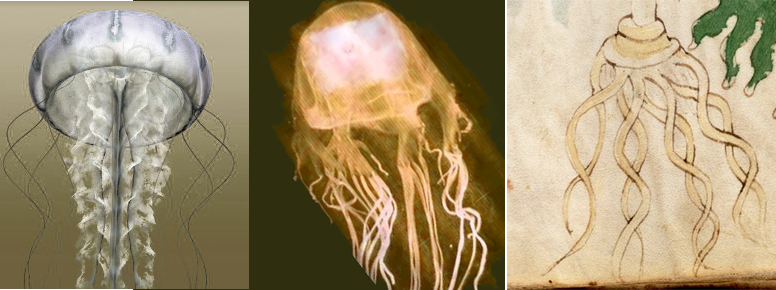 So I looked for marine plants that might match the root of 6r, since it reminded me of jellyfish or anything that might be suspended and moving in mildly active water. Not all aquatic plants are rooted in the substrate. Some of them float in water or have little bladders to walk on water. I didn’t have much success in finding anything that looked substantially like 6r. A number of aquatic plants are included in herbals, sometimes even seaweed, but I couldn’t find a combination of roots, leaves, and seed capsules (or buds) in the plant world that satisfied all the characteristics of Plant 6r.
So I looked for marine plants that might match the root of 6r, since it reminded me of jellyfish or anything that might be suspended and moving in mildly active water. Not all aquatic plants are rooted in the substrate. Some of them float in water or have little bladders to walk on water. I didn’t have much success in finding anything that looked substantially like 6r. A number of aquatic plants are included in herbals, sometimes even seaweed, but I couldn’t find a combination of roots, leaves, and seed capsules (or buds) in the plant world that satisfied all the characteristics of Plant 6r.
Because the VMS illustrator drew most of the plants to fill the pages regardless of their relative size in real life, it’s hard to get a sense of scale. I didn’t want to overlook a plant due to assumptions about its size.
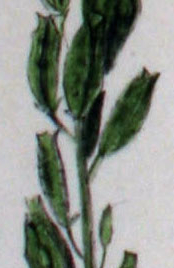 I turned my attention to terrestrial plants, a subject I know better than aquatic plants, and a plant with distinctive seed capsules came to mind.
I turned my attention to terrestrial plants, a subject I know better than aquatic plants, and a plant with distinctive seed capsules came to mind.
I didn’t think it could be Plant 6r at first because this plant usually has a tap root rather than divided roots, but then I recalled my first impression of the VMS root was not only of a jellyfish, but also of tendrils of hair or skeins of yarn… and that’s when I remembered that Reseda is one of the oldest dye plants in the Mediterranean region. Reseda was used to color silk and wool with yellow tones and sometimes to tint medieval manuscripts. Freshly dyed wool is hung out in skeins to dry. Could the roots be suggestive of yarn wafted by the wind? Was the pale yellow color of the roots a reference to plant dyes?
There are many species of Reseda, some with lanceolate leaves and some palmate. Many of them originated in Eurasia or around the Mediterranean and a number of them are valued for their natural dyes as well as for their fragrance. Reseda lutea, and Reseda luteola are probably the two most popular species for dyestuffs. Both have ruffled leaves and long flower spikes with distinctive seed capsules and both have a prominent white vein in the leaves.
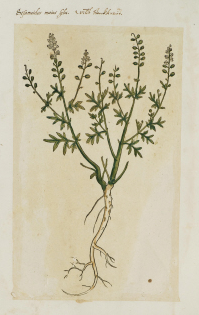 Plant 6r resembles the leaves of Reseda alba more than most of the others. R. alba is endemic to north Africa, Eurasia, and possibly parts of Pakistan or eastern India. It too has distinctive seed capsules, with a reddish “mouth” and bumps that become more prominent as the seeds ripen. The roots of R. alba tend to branch a little more than some of the others, but it is still essentially a tap root and thus doesn’t match the VMS plant unless Plant 6r’s root is intended to be metaphorical.
Plant 6r resembles the leaves of Reseda alba more than most of the others. R. alba is endemic to north Africa, Eurasia, and possibly parts of Pakistan or eastern India. It too has distinctive seed capsules, with a reddish “mouth” and bumps that become more prominent as the seeds ripen. The roots of R. alba tend to branch a little more than some of the others, but it is still essentially a tap root and thus doesn’t match the VMS plant unless Plant 6r’s root is intended to be metaphorical.
R. alba was prized for its fragrance and, in the past, for its medicinal properties, but not so much for its dye as other species of Reseda. Reseda was known to the ancients. It is represented in old manuscripts such as Materia Medica, Circus Instans, and the herbal of Leonard Fuchs.
Assuming for a moment that Plant 6r might be Reseda, what are those bumps on the seed capsules? The seeds do push out along the sides when they ripen, but they don’t poke through and they aren’t as yellow or reflective as the lines in the VMS drawing seem to indicate. I don’t know whether the bumps might be suggestive of the heat coming off of dye pots or if they are meant to suggest the scaly round flowers that come out before the pods, but they obviously were important enough that the illustrator drew several of them.
While Reseda seems like a good candidate, I’m never completely satisfied until I’ve explored other options, so I asked myself, could those seed pods be spore capsules?
Thinking Less Big
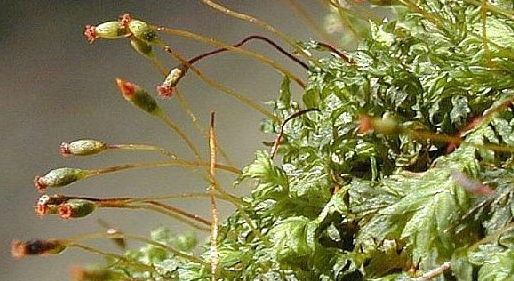
Fissidens bryoides photo copyright Michael Lüth, hosted by the USDA-NRCS PLANTS Database.
Because the leaves and roots of Plant 6r reminded me of aquatic plants, I looked up various wetland species and paid particular attention to mosses, as they have sporophytes that somewhat resemble the distinctive pods of Plant 6r. Mosses are quite variable and many have palmate leaves. Some of them, like Fissidens bryoides (right) develop distinctive reddish tips as the sporophytes ripen.
The spore capsules of Funaria hygrometrica resemble the VMS plant even more than F. bryoides—they are somewhat irregularly shaped and, as they ripen, the “beaks” fall off and they are left with red tips that don’t have fuzzy ends. Isothecium alopecuriodes and Helodium paludosum also have palmate leaves and long spore capsules, but the capsules tend to be brown rather than green and they don’t have distinctive red tips.
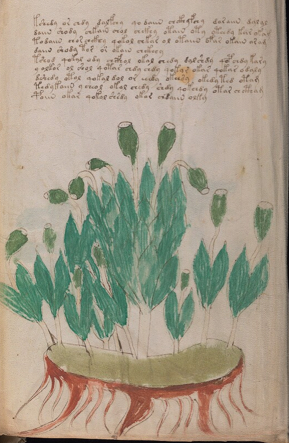 You might question whether there would be moss in the VMS, but some mosses and lichens (e.g., Muscus pulmonarius) were included in medieval manuscripts, particularly species believed to have medicinal properties.
You might question whether there would be moss in the VMS, but some mosses and lichens (e.g., Muscus pulmonarius) were included in medieval manuscripts, particularly species believed to have medicinal properties.
If you look at another VMS plant (Plant 94v shown right), you’ll see that it too could potentially be moss, not only because of the seed heads that resemble sporophytes, but in the way it is clumped and the plants somewhat connected at the base, a common characteristic of moss. Thyme-moss has elliptical leaves and oval spore capsules similar to VMS 94v and might be worth consideration.
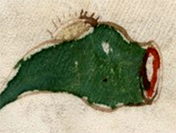 So it’s possible that Plant 6r is moss but what could explain those odd little bumps? I puzzled over that for a long time until I saw a photo of moss that was taken after a rainstorm or perhaps early in the morning when the plants were covered in dew. Each capsule had a tiny drop of water on its back that glinted in the sun, and some of them magnified the texture of the spore capsule, which becomes yellower and more wrinkled as it ripens. Could it be water? It seems as though water would slide off the two spore capsules on the left, so maybe it’s not water.
So it’s possible that Plant 6r is moss but what could explain those odd little bumps? I puzzled over that for a long time until I saw a photo of moss that was taken after a rainstorm or perhaps early in the morning when the plants were covered in dew. Each capsule had a tiny drop of water on its back that glinted in the sun, and some of them magnified the texture of the spore capsule, which becomes yellower and more wrinkled as it ripens. Could it be water? It seems as though water would slide off the two spore capsules on the left, so maybe it’s not water.
There’s another problem with identifying this as moss. There are multiple sporophytes on one stem. That’s unusual, but not unprecedented. I’ve lost track of the botanical name but I believe I found at least one moss with more than one sporophyte per stem. If I locate it again (assuming I’m not remembering it wrong), I’ll upload the name. Suffice it to say that the spore capsules are usually in singles so, if this is moss, it’s either a composite drawing, or a rare species.
Summary
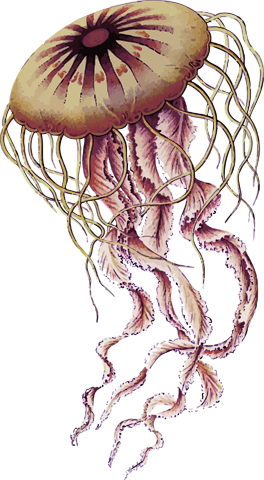 I don’t have a definite ID for this plant. The VMS plant could potentially be either Reseda or moss, even though they’re quite different from one another.
I don’t have a definite ID for this plant. The VMS plant could potentially be either Reseda or moss, even though they’re quite different from one another.
It’s tempting to lean toward Reseda and call the roots a metaphorical allusion to yarn, but many species of mosses grow in wetlands and the roots might be drawn that way to represent a watery habitat. Or… it could be a plant I haven’t yet considered.
J.K. Petersen
© Copyright 2013 J.K. Petersen, All Rights Reserved
